The 32nd ULVAC-PHI Show & Technical Lecture
2015.09.14 Update
The 32nd ULVAC-PHI Show & Technical Lecture
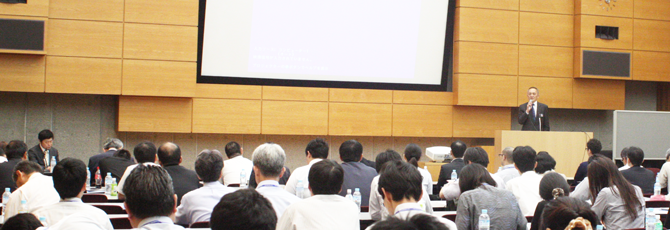
On June 3, 2015, the 32nd ULVAC-PHI Show & Technical Lecture was held at the AIJ Building in Tokyo.
Despite the rain, this event turned out to be almost a full house.

The morning section was presentations on the on-going development projects within ULVAC-PHI and Physical Electronics USA, using actual basic data.
Presentations by the ULVAC-PHI Group
Basic Application of Lab-type Hard X-ray Photoelectron Spectroscopy
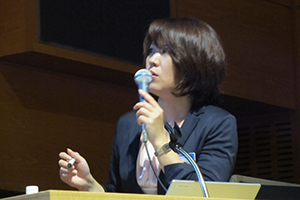
Ms. Risayo Inoue
ULVAC-PHI, Inc.
Analytical Laboratory
ULVAC-PHI’s lab scientist presented some basic data obtained from using the CrKα line, currently under development. The presentation also included research studies from ULVAC-PHI’s joint research partner, Bio-Nano Electronics Research Centre of Toyo University. We are planning on introducing analysis examples of samples we are familiar with, such as evaluation and quantitative analysis of insulators.
New Capabilities Under Development for the PHI nanoTOF II
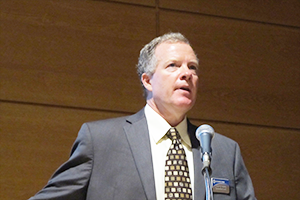
Dr. Scott Bryan
Physical Electronics USA, Inc.
Dr. Scott Bryan, president of Physical Electronics USA, ULVAC-PHI’s US subsidiary, presented on the latest development of TOF-SIMS. Considering the increasing demand in evaluating organic materials, due to the development of the cluster ion technology, the presentation was on the latest trends and future of the development of the TOF-SIMS, mainly on the FIB-TOF aiming to achieve accurate 3D distribution observation.
In the afternoon section, four guest lecturers gave presentations on their expertise.
How Should Manufacturing Advance? What Role Can Analysis Play?
The Relationship between R&D and Analytical Technology in Corporations
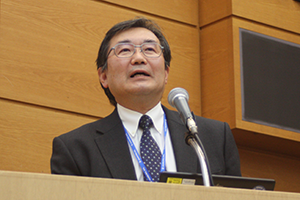
Mr. Hideo Fujimura
Dai Nippon Printing Co., Ltd.
Research & Development Center
The presentation started with the history of the business of the 139-year old company, founded in 1876, which started from printing along with the analytical and evaluation technologies used from time to time.
Analyzing should not just be failure and complaint analysis, but also to propose a pathway in which direction manufacturing should head for.
Mr. Fujimura also shared about how the company trying to deal with evaluating and analyzing human sensitivity, an extremely challenging topic, which comes back to the very basic idea on what analysis is.
High-Quality Cause Analysis
Analytical Approach on Foreign Substances of Products
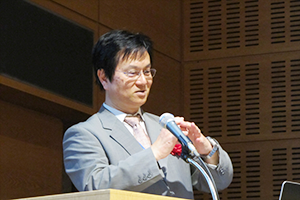
Mr. Hidesumi Obuchi
TOMOEGAWA CO., LTD.
Analysis Center
Mr. Obuchi explained on how the company accumulated analytical skills through quality management and R&D of their products and introduced the procedures of analyzing foreign substances and examples of cause analysis using various analysis methods.
Analysis on foreign substances starts with observing the substances using optical microscopes and SEM, followed by pretreatment such as microdissection and cross-section cutting which determines the chemical analysis method to be used. In addition, He explained the cause of the failure can be determined by combining various analysis methods, from surface analysis techniques such as SEM-EDX and XPS to LC and GC.
The presentation showed how using the adequate analysis method considering the state of the sample and coming up with the valid conclusion is vital for high-quality analysis.
International Standardization for Industrial Use of XPS
Practical Applications of XPS for Industrial Metrology
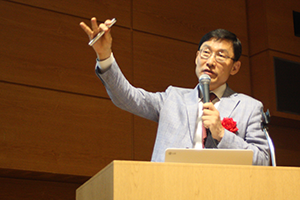
Dr. Kyung Joong Kim
Korea Research Institute of Standards and Science (KRISS)
Dr. Kim stated that “reliability is important for the industrial use of XPS” and listed the following three pillars for securing reliability of XPS analysis results: 1. Traceability (Key comparison by the International Committee of Weights and Measures (CIPM)); 2. Standardization of measurements analysis procedures (ISO standard); and 3. Certified reference materials. He spoke in detail about each of these points, using the example of thickness assessment of SiO2 thin-film on Si substrate.
Additionally, he shared the fact that data measured using PHI VersaProbe II was submitted by KRISS Korea last year on depth direction composition analysis of CIGS thin-film solar cell; this was performed as a core comparison by CIPM.
New XPS for Material Characteritic Evaluation
Practical Applications and Outlook of Hard X-ray Photoelectron Spectroscopy
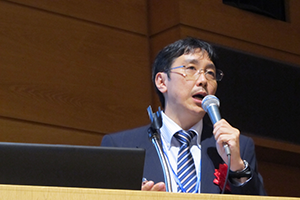
Dr. Hideki Yoshikawa
National Institute for Materials Science (NIMS)
Surface Chemical Analysis Group, Nano Characterization Unit
“Ideally, explaining the correlation between the characteristics of the sample and data should not be difficult in XPS. However, the major cause that is making this difficult is the complex composition and structure of the surface layer due to deterioration from exposing the sample to air,” says Dr. Yoshikawa. He presented analysis examples using Hard X-ray Photoelectron Spectroscopy, an effective approach for solving this issue.
Examples included analysis of samples with internal structures, such as non-destructive in-situ observation, without the effect of surface contamination and Auger peak interference, of band-bending of semiconductors and nano-particle internal dendrimers.
This new XPS could become an incredible useful tool to obtain data from areas previously inaccessible.
Special Thanks to our guest lecturers for preparing and presenting. Thank you to everyone who came, despite the rainy weather.


